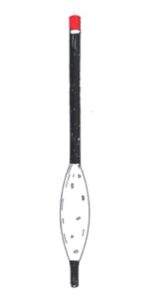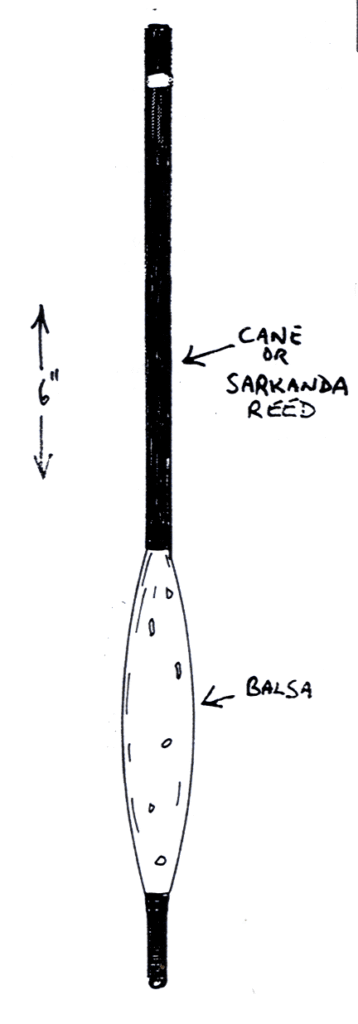🪶 DUCKER WAGGLER

(A Classic Wind-Combatting Waggler from the Golden Era)
The ducker waggler is one of the earliest and most iconic body waggler floats, first recognised in the 1920s. Originally designed to combat a downstream wind on running waters, it quickly proved itself equally effective on stillwaters.
By the 1950s, it had become one of the most popular floats of its time — widely used and illustrated by legendary anglers such as Dick Walker, Fred J. Taylor, and Billy Lane. Although materials and shotting methods have evolved since those early years, the principle and effectiveness of the ducker remain unchanged.
🧰 Design & Features
-
Body: Originally cork; now typically balsa or polystyrene
-
Stem: Traditionally cane, though sarkandas reed or peacock quill may be used
-
Length: 6″–8″ (compact and agile)
-
Base: Sometimes brass-loaded for stability and casting accuracy
-
Attachment: Quick-change float adapters are now common for easy size adjustment
The ducker resembles a mini body waggler — smaller and more compact, with the body acting as a stabiliser to hold the float steady in downstream winds or choppy conditions.
🌊 Why It Works
-
🌬️ Excellent for fishing against a downstream wind
-
🪝 Precise presentation in shallow or mid-depth water
-
🪶 Compact size makes it less prone to being blown off line
-
🧭 Quick-change adaptability for changing conditions
-
🐟 Ideal for dace, roach, and chub in fast rivers
🏞️ Classic Venue: River Usk
One of my favourite places to use the ducker was the River Usk in the Wye Valley. The river is shallow and fast, but holds fantastic shoals of dace up to 14oz.
Fishing in about 4 ft of water, casting mid-river with the ducker was perfect for keeping the float steady in the flow. Bags of 50 lb or more were achievable in a single session — a testament to just how effective this float can be.
⚖️ Shotting Patterns & Setup
-
Carrying Capacity: About 1 Swan shot (plus a couple of No. 4 droppers)
-
Locking: Float bulked at the base with locking shots
-
Optional Method: Some anglers use the split lock shot technique, locking the float with the shots 4″ apart.
-
✅ Advantage: More direct contact upon striking.
-
⚠️ Drawback: More prone to tangles and slightly less casting distance.
-
-
Best Conditions: Slow or still-moving water.
📌 Note: When the split lock shot method can be applied, it gives a crisp, firm hook set on the strike — but it requires good control and a clean cast.
🕰️ 🎣 Classic Float Heritage
“The ducker isn’t just a float — it’s a tool from a golden era of match fishing. Against the wind or in shallow runs, it still holds its own today.” — Clive Branson
🎨 Illustration Box:
-
🪶 Float Type: Ducker Waggler (mini body design)
-
🌊 Ideal Venue: Shallow rivers, slow streams, windy stillwaters
-
🐟 Target Species: Dace, roach, chub
-
🪝 Rigging Tip: 1 Swan shot lock, No. 4 droppers, or split-lock method
-
🧪 Key Advantage: Stable against wind, precise shallow-water control
📘 For historical float designs and modern tactical adaptations, see Clive Branson’s Float Fishing Manual (Paperback & PDF Download).

Now Available: The Complete Float Manual. Over 169 pages of content on Amazon Click on the link below https://amzn.to/4n1QcTy

📘 Download the Complete Float Manual – Instant Access
Bring decades of float-fishing knowledge straight to your screen.
Written by World Champion Clive Branson, The Complete Float Manual is a 167+ page eBook packed with practical techniques, classic float designs, diagrams, and championship-winning methods.
✅ Learn how to use wagglers, stick floats, pole floats and more
✅ Discover the history and evolution of float fishing
✅ Get pro tips and tactics used at the highest level
✅ Ideal for beginners and experienced match anglers alike
💻 Instant Download (PDF) — no waiting, no shipping
💳 Secure checkout with PayPal
👉 Order now and start reading within minutes.
